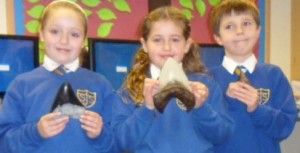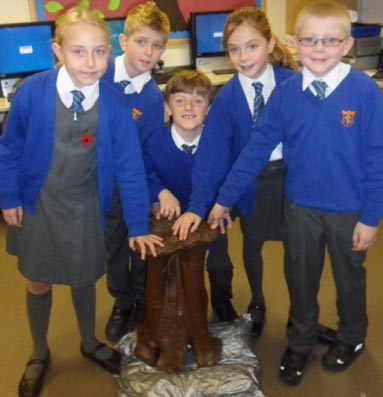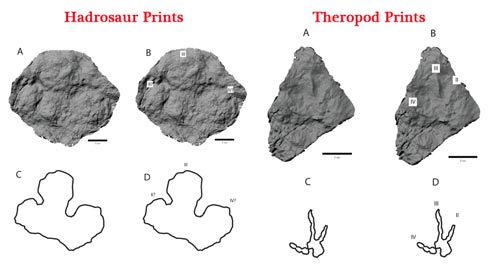Palaeontology at Painsley Catholic College
Primary School Children Track Down Dinosaurs at Painsley Catholic College
Year four and five students attending local primary schools in Staffordshire had the opportunity to visit the well-appointed science labs at Painsley Catholic College and to take part in some dinosaur themed studies. The pupils all from Federation Primary schools which are feeder schools for the College, were invited to join an expert from Everything Dinosaur as part of the College’s outreach programme as teaching staff help to prepare children for the challenges and opportunities of secondary education.
Dinosaur Workshop
The morning’s activities focused around teaching the fundamentals of scientific methodology with the pupils given the opportunity to examine fossils, look at evidence and to come up with their own ideas and theories. As a warm up exercise, the school children were challenged to come up with an explanation as to why there are so few fossils of Triceratops limb bones available for scientists to study.
Toby from St Mary’s (Leek) suggested that the size of the bones could affect the way that some of them might get turned into fossils, whilst Georgina, who was attending from St. Filumena’s (Caverswall, Stoke), thought that the limbs of Triceratops might have been eaten (you might be onto something, Georgina).
Pupils Puzzle over Fossil Teeth
Picture credit: Everything Dinosaur
Triceratops horridus
The children learned that the dinosaur that they had just been studying was called Triceratops horridus, the name means “horrible three horned face” and young Max (St Giles Catholic Primary), demonstrated his considerable knowledge about dinosaurs by explaining the reasons for Triceratop’s name.
Next up came a quick comparison of brain sizes with a cast of part of the skull of an ankylosaurid (armoured dinosaur) used to explain a little about the size of dinosaurs and their brains. Early arrivals, John, Elliot and Holly had looked at the fossilised teeth of a giant marine reptile and they were amazed to learn that if they all laid down head to toe, the length of all three of them would be roughly equivalent to the size of one of this animal’s enormous flippers.
Using such examples can help young scientists understand the sheer scale of some of these prehistoric animals, helping to bring to life what they may have read about dinosaurs or learned at school.
Palaeontology
By way of a quick exploration of ammonite specimens, the school children were provided with a brief guide as to how most fossils are formed and what fossils can tell us about extinct creatures. Rebecca and Ben were able to work out why palaeontologists think that female ammonites were generally bigger than the males. A great example of using knowledge to explore a new concept, to relate what they already knew to a fresh challenge.
The Size and Scale of the Dinosauria
Picture credit: Painsley Catholic College
Studying Dinosaur Tracks
Next came the opportunity to study a set of dinosaur tracks that date from the Early Jurassic. Scientists have uncovered a number of fossilised footprints of animals that congregated around a lake that was drying up. The fossils date from around 190 million years ago and the teacher visiting the school from Everything Dinosaur challenged the pupils to look at the evidence and to come up with a theory as to what a section of tracks might show.
Each of the budding young palaeontologists was given a worksheet, could they work out what the strange set of 190-million-year-old tracks might be revealing? This was a real example of “Walking with Dinosaurs”.
Tasha and Leia (St Josephs Primary School, Uttoxeter) worked out the direction of travel by identifying the marks left by the toes. Isabel calculated that the animal that made the tracks in the mud by the lake, must have had at least three toes. Ellie (St Mary’s) came up with a theory the proposed either a three-toed or four-toed animal had walked that way.
The Importance of Scale Bars
When asked to explain why scientists put a scale bar on their drawings, Niall, Edward and Chris (St. Thomas’ Catholic Primary School), correctly pointed out that scale bars helped scientists to measure the actual size of the prints.
Students Learn About Scale and Scale Bars in Dinosaur Study
The black lines next to the photograph help scientists to appreciate the actual size of the prehistoric tracks.
To learn more about Everything Dinosaur’s outreach work in the community: Email Everything Dinosaur.
Examining the Evidence Formulating Theories
Having examined the evidence and worked through the information the children were then challenged to come up with a theory to explain the unusual prints preserved in the Lower Jurassic sediments. Lots of different ideas were put forward, Joshua and Millie thought that the animal, probably a dinosaur was scratching around in the mud, perhaps it had got stuck and it was trying to free itself.
Peter from St Marys suggested that the tracks might have been made by a wounded dinosaur and perhaps it was limping and staggering – interesting theory Peter. Harriet and her chums from St Giles Catholic Primary School proposed that this dinosaur must have been quite lazy and the tracks represent the places in the mud where it dragged its feet – another intriguing interpretation. Having looked long and hard at the evidence, Ben and Roman came up with the theory that these were the tracks of a dinosaur that had gone for a swim.
Fascinating Theories
All in all, some fascinating theories put forward and a great introduction to some of the methods involved in scientific enquiry. There was even time for Mrs Johnson to organise a set of school photographs of the children holding some of the fossils of prehistoric fish that Everything Dinosaur had brought in. Not too bad for a morning’s work, exploring Late Cretaceous herbivorous dinosaurs, marine reptiles, prehistoric invertebrates and examining strange tracks made in the mud as a Jurassic lake dried up, with the chance to get up close to the teeth of primeval sharks.
A typical day working with the science teaching team at Painsley Catholic College helping to enthuse and inspire the next generation of scientists with a dinosaur workshop.
Visit Everything Dinosaur’s child-friendly and award-winning website: Everything Dinosaur.




